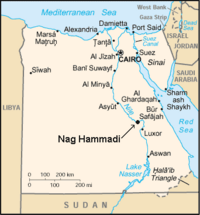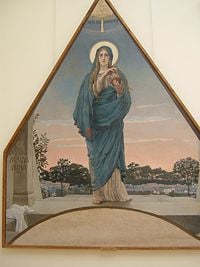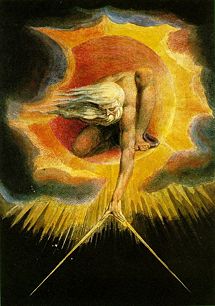Dialogue Of The Saviour
 From Nwe
From Nwe The Dialogue of the Saviour is one of the ancient works of the New Testament apocrypha that was unearthed among the texts of the Nag Hammadi library in Egypt in the mid twentieth century. Constructed as a question-and-answer session between Jesus, Matthew, Mary, and Judas, the work is primarily concerned with the attainment of salvation via gnosis—perfect knowledge.
The Dialogue of the Saviour teaches that the physical body and the material world serve as prisons for the soul, which can only be enlightened by following a difficult path of renunciation of the fleshly passions, especially the "works of woman." The text, however, is not misogynistic, and it presents Mary Magdalene as the disciple who best understands Jesus' teaching. Its negative view of the "works of woman" apparently refers to its teaching that procreation and sex must be avoided in order to escape the cycle of birth-death-and-rebirth and finally enter the bliss of the "Eternal Existent."
The work contains an introduction and interludes which seem to have been edited into the dialog, leading scholars to believe it to be a composite work. It is generally dated to the mid second century, although some believe the dialog portion may be have been composed earlier, perhaps even preceding some New Testament writings such as the Gospel of John.
The text presupposes a basic understanding of gnostic cosmology, and scholars believe that it may have been intended as an instructional or inspirational guide for candidates preparing for initiation into an sect of Gnostic Christianity.
Text and date

The text of the Dialogue of the Saviour was found within in a single Coptic codex at Nag Hammadi, Egypt, in 1945, and is heavily damaged, resulting in numerous missing words, phrases, and sometimes entire passages. Enough of the text is intact, however, to discern its basic outline and teaching.
The major part of the text is a dialog between Jesus and his disciples, Matthew, Mary, and Judas. Mary is almost certainly Mary Magdalene, who often appears in a positive light in gnostic literature, while Judas may be either Judas Iscariot or Judas Thomas (Didymus), both of whom take on a more positive role in Gnosticism than in orthodox Christianity. An introduction appears to have been added at the beginning of the text, in which Jesus is called "Saviour" rather than "Lord" as in most of the dialog, and other material has also been inserted into the dialog, such as a description of two visions, which interrupts the dialog's flow.
Some writers, such as Helmut Koester and Elaine Pagels, hold the core of the work to be quite early, possibly as early as the first century and preceding the Gospel of John. Others consider it to have been written in the early to mid second century. The current text appears to have been copied sometime in the third century, while the Nag Hammadi texts as a whole were buried sometime in the fourth century, possibly as a result of an episcopal edict commanding their destruction. They were discovered by Arab peasants in Egypt digging for fertilizer in 1945.
The gnostic milieu
| Part of a series on Gnosticism |
|
 |
|
History of Gnosticism |
|
Gnosticism |
|
Syrian-Egyptic Gnosticism |
|
Proto-Gnostics |
|
Fathers of Christian Gnosticism |
|
Early Gnosticism |
|
Medieval Gnosticism |
|
Gnosticism in modern times |
|
Gnostic texts |
|
Related articles |
|
Central to many gnostic systems was a dualistic view of the universe, in which matter was seen as essentially evil and illusory, while spirit is the only true reality. Christian Gnostics emphasized spiritual knowledge and experience—rather than faith in Jesus' atoning death and the sacraments of the traditional church—as the key to unity with the divine.
Salvation thus lies in attaining gnosis, the esoteric knowledge kept secret to all but the initiated. Other ideas believed by all or some gnostic groups, include: the spiritual (not physical) nature of Jesus' resurrection, and the femininity of the Holy Spirit or a feminine aspect of the deity. Some Gnostics practiced an ascetic discipline, as appears to be the case in the teachings of the Dialogue of the Savior.
The gnostic cosmology was a complex one, involving the idea that the true God is not identical with the powerful spiritual being who created the physical universe. This creation was either accidental or the intentional work of the Demiurge, thought to be either opposed to or unaware of the true God. In this view, Jesus came to earth as a messenger to enlighten souls and enable them to escape entrapment in the physical world and attain the bliss of reunion with the Divine. Many permutations of the gnostic vision are evident in the corpus of gnostic literature, much of which was only recently discovered in the library unearthed at Nag Hammadi in 1945.
A major issue in attempting to understand the teaching of the Dialogue of the Saviour has to do with interpreting the meaning of the ceremony of the bridal chamber, to which the disciples of Jesus aspire. This gnostic sacrament certainly relates to the spiritual union of the soul of the believer and God or Christ. However, other gnostic texts speak of the bridal chamber in a more overtly sexual context, in which case the apparent commitment to sexual abstinence implied in the text would be only temporary.
Summary
Introduction
The text opens with "the Saviour" speaking to his disciples. He explains that the time has already come "for us to abandon our labor and stand at rest." Anger in particular must not be aroused. Those who know the Father are "the elect and solitary," who have believed the truth. In a manner reminiscent of the Lord's Prayer, the Saviour instructs the disciples to pray:
Hear us, Father, just as you heard your only-begotten son, and received him, and gave him rest… You are the thinking and the entire serenity of the solitary… Through your sacrifice, these [disciples] will enter; through their good works, these have saved their souls from these blind limbs [of the physical body], so that they might exist eternally. Amen.
The prayer is interpreted by some commentators as an precursor to an initiation, either baptism or the gnostic ceremony of the "bridal chamber," both of which are referred to later on in the text.
The Saviour continues, teaching his disciples about "the time of dissolution" which is soon to arrive, during which they must adhere to the truth and pass through the fearful "crossing place" with a "single mind." Unfortunately, the text here is badly damaged.
The dialog
At this point, the dialog begins in earnest. Matthew, Mary, and Judas take turns asking Jesus questions, to which he responds with answers that often appear cryptic to modern readers unfamiliar with the gnostic cosmology.
Judas asks to be told "what was before the heaven and the earth existed." The Lord replies, hearkening back to the story of Genesis, that "There was darkness and water, and spirit upon water." He continues in a more recognizably gnostic vein, although the text here again is damaged:
When the Father established the cosmos… and his word came forth from it, and it inhabited many… a great fire encircling them like a wall… a great and powerful light… (which was) scattered… above and below.
Judas is so enthralled by these words that, "he bowed down… and offered praise to the Lord." Matthew requests "to see that place of life, where there is no wickedness, but rather, there is pure light!" Jesus replies that "you will not be able to see it as long as you are carrying flesh around." He explains that in the meantime, the highest calling is to know oneself: "Everyone who has known himself has seen it in everything given to him to do."
In response to a question from Judas, Jesus teaches that "Whoever does not know the work of perfection, knows nothing." Perfection here indicates perfect gnosis, gained from living in the physical body and material world, but coming ultimately to transcend them:
If one does not stand in the darkness, he will not be able to see the light. If one does not understand how fire came into existence, he will burn in it… If one does not first understand water, he knows nothing, for what use is there for him to be baptized in it? If one does not understand how blowing wind came into existence, he will blow away with it. If one does not understand how body, which he bears, came into existence, he will perish with it.
Interlude
At this point, the dialog is temporarily halted, and Matthew, Mary, and Judas are found at the "edge of heaven and earth," where they behold a fearful vision of "an exceedingly high place and the abyss below." Here, the "Son of Man" greets them and summarizes the gnostic cosmology:
"A seed from a power was deficient, and it went down to the abyss of the earth. And the Greatness remembered it, and he sent the Word to it. It brought it up into his presence, so that the First Word might not fail."
This teaching amazes them, and they accept it as a matter of faith. The disciples now behold two spirits bringing a single soul in a great flash of lightening. A figure called the Son of Man commands that a special garment be given them, "and the small one became like the big one." The Son of Man promises the disciples that they may see the "Eternal Existent," and experience what he describes as "the great vision."

The dialog now recommences, and Judas complains that "the governors dwell above us, so it is they who will rule us," apparently referring to the gnostic concept of unenlightened angelic principalities which stand between the believer and the "great vision." The Lord replies that "It is you who will rule over them! But when you rid yourselves of jealousy, then you will clothe yourselves in light and enter the bridal chamber." Judas asks how the garments of the bridal chamber will be provided, and the Lord responds that they will indeed be given to those who attain the true path. However, he warns that "the garments of life were given to man because he knows the path by which he will leave. And it is difficult even for me to reach it!"
Here, Mary speaks, not with a question, but to make a comment relating to what Jesus has just taught to several recognizable New Testament phrases: "Thus with respect to 'the wickedness of each day,'" she says, "and 'the laborer is worthy of his food,' and 'the disciple resembles his teacher.'" The narrator declares that, "She uttered this as a woman who had understood completely."
Conclusion
Jesus now hints more specifically at the difficult path by which one can escape being trapped in this evil world and obtain the garments of life. "Whatever is born of truth does not die," he explains. "Whatever is born of woman dies."
Mary again speaks: "There is but one saying I will speak to the Lord concerning the mystery of truth: 'In this have we taken our stand, and to the cosmic are we transparent.'" Some interpret this as a statement of her commitment to a life of renunciation, since she has "understood completely."
She soon returns to the role of questioner, drawing the Lord out on another mystery spoken of in the traditional Gospels. "Of what sort is that mustard seed?" she asks. "Is it something from heaven or is it something from earth?" Jesus replies: "When the Father established the cosmos for himself, he left much over from the Mother of the All. Therefore, he speaks and he acts."
Judas seeks clearer guidance: "How should we pray?" he asks. Jesus replies simply: "Pray in the place where there is no woman." Matthew explains to Judas that this means the same as "Destroy the works of womanhood." It it not, he explains, because there is any other manner of birth into this world, but "because they will cease giving birth." Judas agrees: "the works of womanhood will dissolve." Thus, they both come to the same commitment Mary has already affirmed, apparently involving a life of sexual abstinence.
Jesus confirms that the men finally have begun to understand. "Right… Now behold! A true Word is coming forth from the Father to the abyss, in silence with a flash of lightning, giving birth… And you will go via the path which you have (now) known… But listen—I tell you that it is difficult even for me to reach it!"
The conclusion of the dialog's text, once again, is badly damaged. It ends with an admonition that these teachings have been given "so that you will not lead your spirits and your souls into error."
Analysis
The Dialog of the Savior, beyond its cryptic language and damaged text, proceeds rather clearly along the lines of gnostic instruction. It begins with a call to discipleship based on the goal of attaining "rest" through single-minded truth seeking. It then expands on this theme by having the Lord explain to the three seekers several of the key teachings of gnosis. The body is composed of "blind members," anger and other passions must not be aroused, and the ultimate truth cannot be perceived while still in the body. In the meantime, knowledge of oneself is the highest calling.
In the coming "dissolution," the soul must find its way past a fearful crossroads, caught between the heights and the abyss. "The Greatness" has sent its seed, the Word, to enlighten those who seek the truth with a single mind and achieve the right to enter the bridal chamber. This is no easy path, even for the Lord himself, as it involves "destroying the works of womanhood," by adhering to an ascetic path of renunciation. Mary understands this teaching implicitly, and ultimately Judas and Matthew, too, come to commit themselves to this way. Jesus concludes with a word of hope and warning: "A true Word is coming forth from the Father to the abyss, in silence with a flash of lightning, giving birth." And yet even for him, the path to enlightenment is difficult to attain.
Importance
Since the Dialog of the Savior is not recognizably mentioned in the writings of the Church Fathers, it is difficult to assess its importance in terms of popularity. However, scholars believe it represents a significant early development in the history of gnostic literature, moving from a strictly "sayings"-based text to a more sophisticated genre involving dialog, visions, and a limited amount of action.
More important, the Dialog of the Savior provides a glimpse into the spiritual life of new gnostic believers preparing for their initiation into the mystery of baptism and/or the bridal chamber. Despite the poor condition of the text, we are fortunate that it has been rediscovered. Further study is bound to reveal additional insights not only into the text itself, but its relationship to others and its place in both the gnostic and Christian traditions.
See also
- Gnosticism
- New Testament Apocrypha
- Demiurge
- Nag Hammadi library
References
ISBN links support NWE through referral fees
- Emmel, Stephen, Helmut Koester, and Elaine H. Pagels. Nag Hammadi Codex III, 5, the Dialogue of the Savior. Leiden: Brill, 1984. ISBN 9789004075580.
- Meyer, Marvin W. The Gnostic Gospels of Jesus: The Definitive Collection of Mystical Gospels and Secret Books About Jesus of Nazareth. San Francisco: HarperSanFrancisco, 2005. ISBN 9780061348303.
- Meyer, Marvin W., and Esther de Boer. The Gospels of Mary: The Secret Tradition of Mary Magdalene, the Companion of Jesus. San Francisco: HarperSanFrancisco, 2004. ISBN 9780060727918.
- Os, Lubbertus Klaas van. Baptism in the Bridal Chamber: The Gospel of Philip As a Valentinian Baptismal Instruction. 2007. ISBN 9789036729727.
- Zandee, Jan. Gnostic Ideas on the Fall and Salvation. Leiden: E.J. Brill, 1962. OCLC 233677088.
External links
All links retrieved July 28, 2022.
- Online test of Dialogue of the Saviour. gnosis.org
- Introduction and resources. earlychristianwritings.com
Credits
New World Encyclopedia writers and editors rewrote and completed the Wikipedia article in accordance with New World Encyclopedia standards. This article abides by terms of the Creative Commons CC-by-sa 3.0 License (CC-by-sa), which may be used and disseminated with proper attribution. Credit is due under the terms of this license that can reference both the New World Encyclopedia contributors and the selfless volunteer contributors of the Wikimedia Foundation. To cite this article click here for a list of acceptable citing formats.The history of earlier contributions by wikipedians is accessible to researchers here:
The history of this article since it was imported to New World Encyclopedia:
Note: Some restrictions may apply to use of individual images which are separately licensed.
↧ Download as ZWI file | Last modified: 02/04/2023 08:41:04 | 3 views
☰ Source: https://www.newworldencyclopedia.org/entry/Dialogue_of_the_Saviour | License: CC BY-SA 3.0
 ZWI signed:
ZWI signed:
 KSF
KSF